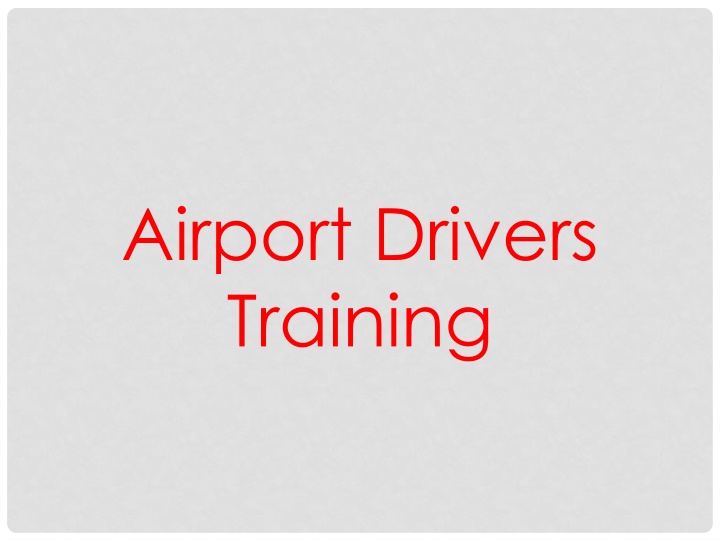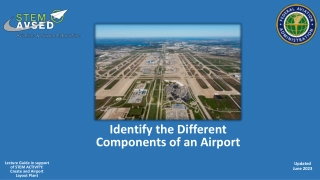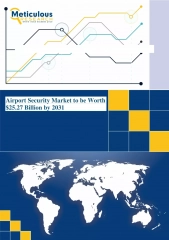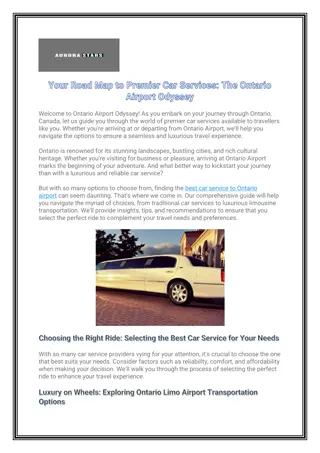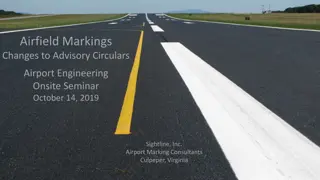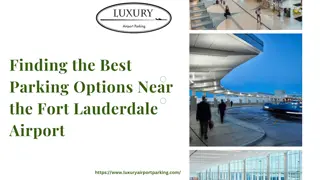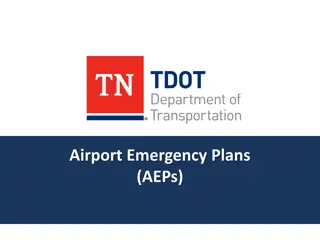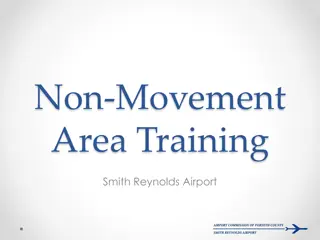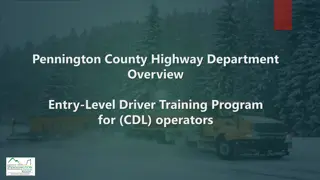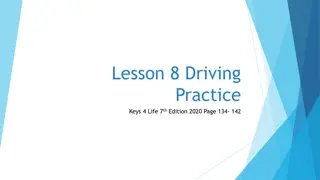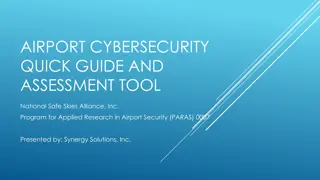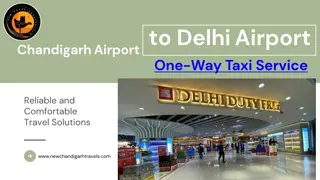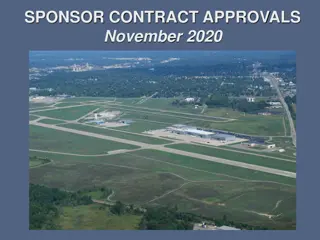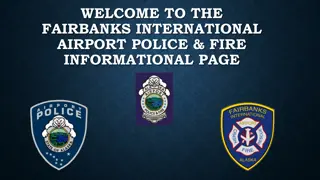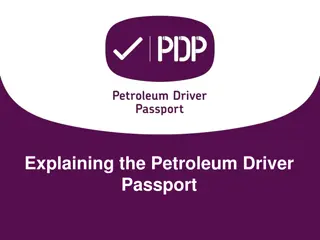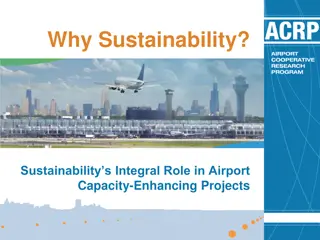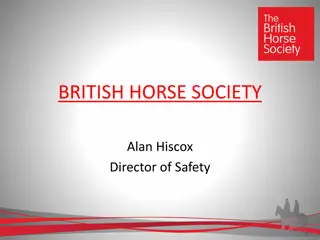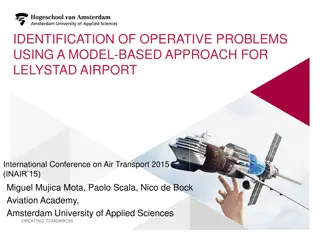Airport Drivers Training Program for Safety on the Airfield
Airport Drivers Training Program focuses on preventing runway incursions and surface incidents caused by human error at airports. The program covers course objectives, vehicle requirements, definitions of incidents, and the importance of safety protocols on the Air Operations Area (AOA) and apron. Training includes airport familiarization, communications, driving practices, and practical experiences to enhance safety for all personnel working on the airfield.
Download Presentation

Please find below an Image/Link to download the presentation.
The content on the website is provided AS IS for your information and personal use only. It may not be sold, licensed, or shared on other websites without obtaining consent from the author.If you encounter any issues during the download, it is possible that the publisher has removed the file from their server.
You are allowed to download the files provided on this website for personal or commercial use, subject to the condition that they are used lawfully. All files are the property of their respective owners.
The content on the website is provided AS IS for your information and personal use only. It may not be sold, licensed, or shared on other websites without obtaining consent from the author.
E N D
Presentation Transcript
Airport Drivers Training
PURPOSE Runway incursions and surface incidents pose a serious and growing threat to safety at our airports. Almost all known runway incursions and surface incidents can be linked to human error in the complex airport environment. Preventing these incidents is the responsibility of everyone in the aviation community.
PURPOSE Airport Driver Training Programs are intended to prepare employees for operating safely on the airport s surface. Don t let this be you
COURSE OBJECTIVES Definitions Vehicle Requirements Airport Familiarization Airport Communications Driving on the Airport Practical Experience
VEHICLE REQUIREMENTS All Vehicles Operating in the Air Operations Area must be equipped with the following at a minimum: Operating Headlights Operating Taillights Rotating or Flashing Yellow Beacon Two-way Aircraft Transceiver Fire Extinguisher
DEFINITIONS Runway Incursions A runway incursion is any occurrence at an airport involving an aircraft, vehicle, or person or object on the ground, that creates a collision hazard or results in a loss of separation with an aircraft taking off, intending to take off, landing, or intending to land . Accident - a collision between one aircraft or vehicle and another aircraft, vehicle, person or object which results in property damage, personal injury, or death.
Aircraft Incident an occurrence, other than an accident, associated with the operation of an aircraft that affects or could affect the safety of operations. Air Operations Area (AOA) - those areas that encompass the runways, taxiways, aprons and other areas of the airport intended to be used by aircraft for taxiing, takeoff, landing, maneuvering, and parking. Also operating on the AOA are the vehicles necessary to service aircraft operations. Apron or Ramp - a defined area on an airport or heliport intended to accommodate the parking and servicing of aircraft, the loading and unloading of passengers and cargo, refueling, maintenance and other servicing operations.
Displaced Threshold - a threshold for landing that is located at a point on the runway other than the designated beginning of the runway. Hold Bar -Used to identify the location where a pilot or vehicle is to stop when clearance has not been granted onto a runway.
Movement Area - the runways, taxiways, and other areas of an airport which are utilized for taxiing, air taxiing, takeoff, and landing of aircraft, exclusive of loading ramps and parking areas. Runways -those parts of the AOA used for the takeoff and landing of aircraft. Taxi - the movement of an airplane under its own power on the surface of an airport Taxiways - those parts of the AOA designated for the surface maneuvering of aircraft to and from the runways and aircraft parking areas. Tie Down Area (Ramp) an area used for securing aircraft to the ground.
AIRPORT FAMILIARIZATION Replace photo with local airport photo Runway 9/27 Taxiway A Movement Area Aircraft Parking Apron (RAMP) Taxilanes Non-movement Area
AIRPORT COMMUNICATIONS UNICOM (Universal Communications) station is an air- ground communication facility operated by a non-air traffic control private agency to provide advisory service at uncontrolled airports and to provide various non-flight services Announce intentions on Bult UNICOM 123.0 Wait for reply Visually check for aircraft in the traffic pattern Announce intentions again Proceed onto the runway Continue to monitor UNICOM and maintain visual surveillance for aircraft
ANNOUNCEMENT EXAMPLES Operations 1 entering runway niner for runway safety inspection Bult Field. Any Bult traffic please advise. Operations 1 entering runway two seven for runway safety inspection Bult Field. Any Bult traffic please advise. Operations 1 clear of runway niner, Bult Field Operations 1 clear of runway two seven, Bult Field
Phonetic Alphabet A- Alpha B- Bravo C- Charlie D- Delta E- Echo F- Foxtrot G-Golf H-Hotel I - India J- Juliet K-Kilo L- Lima M-Mike N- November O-Oscar P- Papa Q-Quebec R- Romeo S- Sierra T- Tango U- Uniform V- Victor W-Whiskey X- X-ray Y- Yankee Z- Zulu
Driving on the Airport 1. Always use the authorized service roads whenever possible 2. Do not operate vehicles or any other equipment in the vicinity of a fuel spill other than authorized emergency vehicles. 3. Vehicles parked in the immediate vicinity of an aircraft must be parked in such a way as to be facing away from the aircraft with the emergency brake set. 4. Do not drive, push or place any equipment under any part of the aircraft unless to perform the special services for which the equipment is designated. Equipment shall be positioned so that adequate clearances are maintained to protect for possible movement of flight control surfaces, such as flaps, etc.
5. Do not allow anyone to stand up, or ride on the running board, or ride on a vehicle with his/her arms or legs protruding from the body of a moving vehicle, unless such motor vehicle is so specifically designed and designated. 6. Vehicle operators of any motor vehicle (including forklifts, tractors and tugs) shall not carry passengers unless the vehicle is equipped with approved seats as appropriate for passengers. 7. Never allow anyone to disembark from a moving vehicle until it has come to a complete stop. 8. Do not allow anyone to ride in any towed or pushed unit unless such a vehicle is designed for passenger transport.
9. Never park a motor vehicle or other equipment in such a way that it might interfere with, or prevent, the passage or movement of aircraft, emergency equipment or other motor vehicles. 10. Do not back up a truck or other construction or motorized vehicle ground equipment (excluding private passenger automobiles and small baggage tractors) unless a guide-man is positioned to assist the back-up operation. 11. All vehicles when approaching from opposite directions shall pass to the right of each other and not stop when opposite each other.
12. Never operate a motor vehicle within the Airport AOA in a reckless manner or with a disregard for the safety of other persons or property. 13. Never discard objects from any vehicle, either standing or in motion, at anytime. 14. Smoking is prohibited, both inside and outside of vehicles, anywhere in the AOA, including all ramp areas, taxiways, and runways. 15. Never operate a motor vehicle unless the vehicle headlights and taillights are kept illuminated between the hours of sunset and sunrise and at all times when passing through unlighted areas or when visibility is poor.
16. Never operate a motor vehicle if packages, equipment or an extended superstructure obstructs the driver s forward vision. 17. Exercise extreme caution for aircraft entering and exiting ramp areas and taxiways that cross vehicle traveled routes. 18, Exercise extreme caution for numerous persons on foot and small aircraft when traversing the general aviation parking ramps. 19. Exercise extreme care to insure that all equipment is secure from jet blast at all times.
20. Never cross pedestrian and passenger access routes between aircraft and the terminal except those vehicles servicing the aircraft. All other vehicles must travel behind the aircraft at a safe distance. 21. Never park any motor vehicle or other equipment in such a way as to block access to any fire hydrant, emergency fuel shut off device or other fire control equipment. 22. Use caution (especially at night) for wing tips of parked aircraft that may overlap vehicle service lanes on the terminal ramp. 23. Never operate a motor vehicle in such a way as to pass directly under the wings, nose, or tail area of an aircraft unless said equipment will be used in servicing the designated aircraft.
24. Other than the operator of a vehicle servicing the designated aircraft, do not operate a motor vehicle so as to pass within twenty feet of a parked aircraft. 25. All trucks and equipment operating on the Airport in connection with the servicing of aircraft must be parked only in designated areas and in such a manner that permits departure from the parking area in a forward direction. 26. Operators must exercise caution for aircraft tires and brakes on aircraft that have just landed. Because tires and brakes can be hot and dangerous, persons that must approach the aircraft should do so from the front or rear, and never from the side. Aircraft brakes may explode with great force, blasting hot metal to each side of the wheel.
27. Motorized equipment may not be positioned within ten (10) feet of the aircraft fuel vents during the refueling operation. 28. Vehicle operators shall exercise extreme caution for aircraft fueling operations and ensure that adequate separation is maintained between them and all mobile fuel vehicles. 29. Ramp personnel responsible for the towing operation shall ensure proper wingtip clearances are kept at all times. If a conflict arises, personnel must take the appropriate steps to guarantee safety. 30. Wingwalkers shall be used for all aircraft towing operations
Speed Limits 1. Never operate any vehicle, other than an emergency vehicle proceeding in response to an alarm, within the AOA perimeter, at a speed greater than twenty miles per hour. 2. Never operate a motor vehicle on aircraft ramps, or in close proximity to parked or taxiing aircraft, or adjacent to buildings or obscured areas at a speed greater than ten miles per hour. 3. Never operate a motor vehicle in the of a parked or taxiing aircraft at a speed that is greater than normal walking speed, or in a manner, which is considered unsafe or unreasonable.
4. To insure positive brake action on slippery surfaces, operators shall use extreme caution and reduce speed to allow for proper vehicle control. 5. Specified speed limits shall not relieve the operator of exercising caution and positive control at all times, particularly during hours of darkness, diminished visibility and abnormal weather or surface conditions Always Remember Under all circumstances Aircraft have the Right-of-Way
Accident Reporting All accidents must be reported to the Bult Airport Manager immediately. Even the smallest incident between a vehicle and an aircraft can have a serious affect on the safety of flight. Accidents should be reported by calling the Operations Office at the designated telephone number. Persons involved in the incident must remain at the scene until the Airport Manager or his designee have finished gathering information, questioning witnesses and taking pictures if necessary.
QUESTIONS ????
